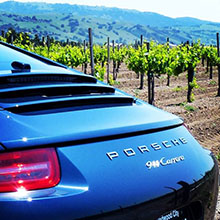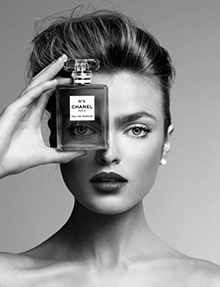Champagne Glasses / Stemware Review
There is a wide variety of champagne glasses to choose from. This section discusses what to consider for every occasion and reviews the various types of glasses. We also provide recommendations based on various circumstances and budgets. The following are the topics covered.
Champagne glasses play an important roll in the champagne experience. The type of container you select can make a significant difference in how sparkling wine tastes. The following presents the key factors that effect the taste of sparkling wine.
What to Consider When Selecting Champagne Glasses
For the best champagne experience, there are a few basics to consider. The following discussion is written with ideal circumstances in mind. However, there may be good reasons to deviate from the ideal. For instance, plastic does not break as easily as glass or crystal and may be more practical in some circumstances. There are also price considerations. The advantages and disadvantages of the various types of glasses are described in the Types of Champagne Glasses section. The following discussion provides key points to be aware of when making a selection.
The Stem
Champagne glasses should have a stem. Holding the glass by the stem keeps the wine from being warmed by the heat of your hand. Exceptions: There are some manufacturers that produce a glass with a hollow leg (perhaps more sturdy than traditional stemmed glasses) to hold the glass. There are also manufacturers producing champagne glasses with thick stems. Your hands won’t warm the champagne because they don’t directly contact the bowl containing the champagne. It is thought that this shape (along with a round bottom bowl for the liquid) may enhance the bubbles.
The Rim
Champagne glass should have a thin polished (cut) rim rather than a rolled rim. Rolled rims present a barrier to the flow of champagne onto the palate. Polished/cut rims deliver the wine smoothly onto the palate.
Clarity
Champagne glasses should be transparent/clear. Colored or frosted glass inhibits the visualization of the bubbles and the actual color.
Size
Typical champagne glasses are approximately 7 to 8 inches tall. The stem is about 3 ½ to 4 ½ inches and the bowl is 3 ½ inches high. The opening has a diameter of 2 ½ inches while the widest diameter is 3 inches. A full bottle of 750ml champagne will fill 5 glasses of this size 2/3 full or 8 glasses half full.
Imperfections
Nucleation points or slight imperfections in a champagne glass (as well as dust or lint) are what stimulate bubble formation. If you pour champagne into a totally clean glass with no imperfections or scratches, it will not bubble. Scientifically speaking, the bubbles need something on which to form. If bubbles don’t form in the glass, there will be more bubbles when the champagne enters your mouth.
Types / Shapes
There are many types of champagne glasses that come in many different shapes. The shape of a glass makes a difference in the taste and aromatic experience. Follow the links for a description of each type.
Crystal, Glass or Plastic?
Crystal vs. Glass
Champagne glasses should also be made from crystal. The argument for crystal, as opposed to regular glass, is that crystal is typically considered to have a higher refraction index which enhances the appearance of the champagne in the glass adding reflective properties and brilliance. Crystal is also rougher than glass. The roughness and slight imperfections help stimulate bubble formation. For this reason, I advocate crystal for champagne glasses more than other wine glasses. For still wine, crystal allows the wine to breathe more efficiently when swirling. Sparkling wine doesn’t need to be swirled since swirling will cause the carbonation to disseminate too quickly and the wine will go flat.
Should champagne glasses be lead or lead-free crystal? A crystal champagne glass has traditionally been leaded crystal, but leaded crystal is becoming rare due to health concerns. There are many manufacturers with beautiful versions that produce lead free crystal. Lead raises the refractive index slightly more than lead free versions so the sparkling appearance of the glass will be somewhat more pronounced. Lead in champagne glasses tends to make the glass more pliable and easier to work with during production. Non-leaded crystal employs the use of elements such as zinc or potassium oxide instead of lead oxide. These will appear to be lighter with slightly less dispersion of light, but they are still quite suitable. Lead crystal champagne glasses are generally not considered to pose a health risk. The primary risk comes when liquid or food is stored in leaded crystal for long periods of time. The quantity of lead that leaches out of a champagne glass after standing for a few hours is much smaller than normally consumed in a regular diet. However, it is not a good idea to store liquids in leaded crystal receptacles such as decanters for long periods of time.
Plastic
The Plastic Champagne Glasses section discusses plastic in detail.
Reviews and Recommendations
The better the champagne, the more attention should be paid to the champagne glass. In general, for non-vintage champagne, a tulip glass work well. White wine glasses are good across the range of champagne styles. For a great rose’ that’s not too old, you might want to try a Burgundy or Bordeaux glass. For a true splurge, try the Impitoyable champagne glass. If you are craving the aesthetics of seeing the mesmerizing bubbles, you aren’t serving a top quality cuvee and you aren’t terribly concerned with the nose and palate, you might prefer to opt for a flute. The bottom line is to experiment and see what pleases you. That is what matters the most.
More About Champagne Glasses:
|





